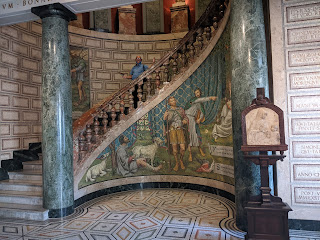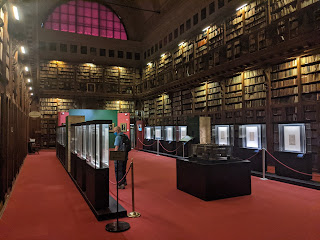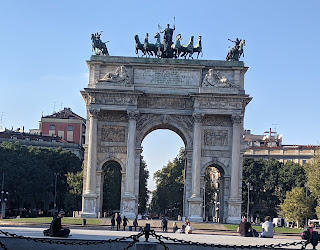You can imagine my heart jumped a beat seeing this Canadian store while Steven and I wandered around Milan toward San Maurizio al Monastero Maggiore, a church that was part of a 9th-century convent built into part of Milan's ancient Rome wall.
We were really bummed that the church with its amazing frescoes by Bernardino Luini was closed each of the three times we tried to enter, including the last when we even had timed reservations. Luini was influenced by contemporaries Michangelo and Raphael and was a follower of Leonardo, certainly very exalted company!
Instead, we walked around the courtyard of the adjacent Archaeological Museum where we viewed some interesting bits. These massive bases carved in the shape of an eagle's talons and decorated on the sides with leafy tendrils were found together in a ditch that encircled the ancient city wall. Archaeologists surmised that they may have belonged to a funerary monument or public building.
The cornices were found together and must have been part of a great monumental complex in which expensive imported marbles were used. The location and purpose of the building, possibly a library, gymnasium, or imperial cult site, are unknown but it may have had halls for displaying statues honoring the reigning emperor, Marcus Aurelius.
These capitals were of immense historical importance because they were the oldest evidence of a monumental public building, likely a temple, constructed when Milan, then called Mediolanum, was still a Celtic village with earthen and wooden structures that were undergoing Romanization. The decision to use stone and Hellenistic central-italic styles indicate a desire to adopt the models of Rome which was the center of power.
The sarcophagus was dedicated with images that told the life of Caius Valerius Petronianus, a young lawyer that belonged to the Milanese aristocracy who died at the age of just 23. He is pictured on the front wearing both Greek and Roman clothes. On the sides, he was shown reclining on a couch holding a laurel wreath while a servant carried a container for inscribed rolls. Also depicted was Petronianus, accompanied by his father, arguing a legal case before a court official while sitting on a high tribunal or seat.
The last item we saw at the museum was a solid marble block decorated on two and a half sides with dolphins being ridden by Cupid that would have been the base of a column from the age of Hadrian, 117-138 AD. In the Early Middle Ages or 5th-6th-century, the block was hollowed out which created a central vat with four round bowls on the corners to be used as a drinking trough. A third interpretation was that it was used for dying cloth. In the 10th-century, the piece became an urn in which were placed the remains of the Archbishop of Milan's parents.
For a different change of pace, we then walked over to Piazza degli Affari, a square and monument in the middle of Milan’s financial district. These “bold fascist buildings” were constructed under Mussolini. Italy’s major stock exchange, the Borsa, faced the square. Seeing it reminded us of the original stock exchange started by the Beurse family in Bruges, Belgium at the beginning of this trip. The statues represented various laborers and occupations and celebrated the nobility of the working class – i.e. typical fascist themes.
You couldn’t possibly miss the in-your-face middle finger modern statue in the square that won a 2009 competition to find the “most appropriate sculpture” to grace the financial district! Designed to be just temporary, locals loved the 36-ft. tall Carrara marble sculpture so much it has remained. It sure looked like sculptor Maurizio Cattelan was wanting to notify the one-percenters in their bastion of corporate power how the 99 percenters felt in light of Italy’s ongoing financial problems.
More scenes from our walk through the financial district:
This mural went on for several blocks. I wasn't sure whether it was an ode to Milan's fashion scene or what.
Piazza Cordiuso was one of Milan's showpiece squares and the very heart of the financial district of the city that has been the country's financial and commercial center since Italy's unification. It was laid out between 1889 and 1901.
Neither of us objected to having an excuse to again pass through the gorgeous Galleria Vittorio Emanuele II that we'd first discovered the day before.
After learning that the nearby Spontini was famous for its Sicilian style of pizza by the slice, we had to give it a try! Being avid pizza fans, it sure passed our taste test.
Just a few steps from the hectic and noisy Piazza del Duomo we’d visited the previous day was Piazza dei Mercanti or Square of the Merchants that had been the center of political power in the 13th-century. The red-brick, arcaded building that dominated the middle of the square was the Palazzo della Ragione or City Hall.
In the center of the square was a balcony with coats-of-arms where new laws were announced. When two big families, the Visconti and Sforza, took power with the snake as their symbol, they shaped much of the Renaissance and the present-day city of Milan. The Sforza family made peace with the Venetians and were friendly with the Medicis in Florence who enabled them to become successful bankers. Thus unfolded a time of peace and tranquility among the city-states allowing money to be made available for art to thrive during the Renaissance generation instead of war.
The square also contained the 16th-century Palace of Justice, the courthouse with the clock tower, and a crafts market selling leather, gold, and iron goods, a bank, the city’s first university, and its prison. It was amazing that one relatively small square could contain so many elements of a great city!
Pinacoteca Ambrosiana, Milan’s oldest museum, was opened in 1618 to showcase the painting and book collection of Cardinal Federico Borromeo after initially being a teaching academy. There was an amazing collection of works by such masters as Botticelli, Leonardo da Vinci, Raphael, Titian, Caravaggio, and Brueghel.
The Holy Family by Bernardo Luini, a northern Italy painter in Leonardo's circle during the High Renaissance:
Cristo Benedicente, also by Luini:
We headed upstairs to admire Raphael’s Cartoon which was an outline for his famous School of Athens fresco we hoped to see in a few weeks at the Vatican Museums in Rome. Obviously not a cartoon in the English-language sense, a cartoon or cartone in Italian was a full-size sketch that was used to transfer a design to another surface. Though the Vatican’s fresco was attributed entirely to Raphael, it was actually mostly painted by his students. By contrast, this cartone was the work of Raphael.
The cartoon in the Ambrosiana is the only one of its size that has been preserved to the present. The painting depicted the greatest thinkers of ancient times gathered around the key figures of Plato and Aristotle.
Plato pointed upwards to indicate the world of ideas while Aristotle's gesture might instead indicate the reconciliation of extremes.
In order to transfer the design to the pope’s study, Raphael’s assistants placed pinpricks on the outlines of the figures. When the cartone was then removed, the figures’ shapes were marked on the wall so that their interiors could be filled in much like a coloring book!
I read that Raphael depicted himself among the philosophers to indicate that the creative processes in art were an intellectual activity similar to philosophy.
The identity of the man crowned with leaves is uncertain though the most accredited hypothesis is that he might be Orpheus, a musician, poet, and prophet in Greek mythology.
Pythagoras was depicted writing surrounded by his disciples.
Diogenes the Cynic lay isolated to remind us of his solitary habits and his wish to reduce physical needs to the essential.
Euclid, the author of The Elements, was surrounded by young disciples and while drawing a geometric figure.
The second figure on the right was Zoroaster, who in ancient times was seen as the founder of astronomy. He was holding the celestial globe while Ptolemy, the author of The Geography, was holding the terrestrial globe.
It was an absolute thrill being able to fully understand and appreciate Raphaeil's cartone after examining the work in detail.
One entire room in the museum was dedicated to Flemish masters such as Jan Brueghel the Elder because the museum's founder, Borromeo, was friends with the artist.
The Brueghel series called The Four Elements were requisitioned in the Napoleonic era and brought to Paris. Unfortunately, only these two of the four commissioned by Borromeo, Allegory of Fire and Allegory of Water, were returned to the Ambrosiana museum.
Even more paintings by Brueghel graced the room. When asked why the cardinal liked collecting secular paintings, he would have said "Secular themes are God's book of nature."
Milanese craftsman Giuseppe Bertini, 1825-1898, created the Dante Window masterpiece.
The Room of the Medusa was the first room in the new wing acquired by the Pinacoteca in 1928 when the Ambrosiana took possession of the Basilica of the Santo Sepolcro and the adjoining buildings. The room, named after the Medusa fountain sculpted by Giannino Castiglioni, displayed Ambrosiana's most important collection of objects and some Renaissance paintings.
The Room of the Exedra was set up in 1930-31 on the 2,000th anniversary of Virgil to celebrate 16th-century painting and the large mosaic which reproduced the miniature by Simone Martini contained in the Virgil Codex.
I almost drooled seeing these sublime mosaic 'pictures' under the staircase.
The room also contained several Venetian paintings from the 16th-century. Ritratto di senatore veneziano by Tintoretto:
Statues above the stairway:
With so much beauty on the walls, sometimes it was easy to not pay attention to the floors but what a mistake that would have been as they were often as spectacular as the rest of the rooms themselves!
Biblioteca Ambrosiana was the museum's 17th-century library that hosted a revolving display of sketches and notes by Leonardo from his own thousand-page Codex Atlanticus or reference guide. Sixteen pages were on display showing just a smidge of da Vinci's genius. We had to access the library via a curtain to limit light damage to the invaluable books and manuscripts.
The display case for Codex Atlanticus:
The only painting of da Vinci’s to remain in Milan was Portrait of a Musician, almost as mysterious and delicate as the Mona Lisa. We were extraordinarily fortunate to be able to see this painting that had been temporarily placed in the library as the entire Leonardo Hall was undergoing renovations when we visited.
The rear of the Biblioteca and, therefore, of the Pinacoteca:
Milan's grand pedestrian boulevard and shopping mecca was Via Dante which led from the Duomo at one end to Sforza Castle at the other. The street honored the country's unification in 1870 and also cemented Milan's place as a top metropolis.
It was great fun strolling along the cobblestoned street that was packed with cafes and interesting stores to window shop as we made our way to the castle.
In front of the castle was a commanding statue of Giuseppe Garibaldi, the hero of the unification movement, casting his gaze down on one of Europe's longest pedestrian zones. We'd already walked more than eight miles that day and had several more to go before returning to our apartment so we only walked through the castle that afternoon as we knew we'd return the next day.
On the far side of the castle was Sempione Park, Milan's equivalent to New York's Central Park with an aquarium, English-style gardens, and a great place to hang out in.
If you remember playing with erector sets as a child, the Branca Tower might look familiar! It was built in the 1930s for an exposition.
At the far end of the park was Arco della Pace or Arch of Triumph that was constructed facing Paris to welcome Napoleon's rule and salute the ideals of the French Revolution. Nike, the goddess of victory, stood atop the arch as she commanded a chariot of six horses. Once locals learned of Napoleon's skulduggery, the horses were turned around so their backsides faced France!
Milan's trams appeared very atmospheric and had lots of character - i.e. were ancient! They reminded us both of the yellow trams plying the hills in Lisbon.
How I would have loved to have had room in my bag for two of these for Max and Clara, our young granddaughters!
Though Steven and I were plenty tired as we neared our apartment, the sight of lovely tree-lined streets like this perked us both up after a long day discovering more of what can only be described as majestic Milan.
Next post: Sforza Castle and its museums.
Posted on November 29th, 2021, from Denver just a day before leaving for several weeks in French Polynesia and then celebrating Christmas in San Francisco with our son and his family on the way home. Having just returned from a couple of months gallivanting around Europe, it wasn't our first choice to leave a week later on another international trip. However, this was our last chance to use up flights we'd had to cancel when Covid shut down international travel last year. We were just lucky we didn't lose these tickets even if the timing wasn't optimal.























































































No comments:
Post a Comment